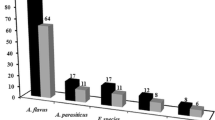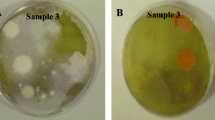Abstract
An extensive survey of filamentous fungi isolated from wheat grown and consumed in Lebanon and their capacity to produce aflatoxin B1 (AFB1) and ochratoxin A (OTA) was conducted to assess fungi potential for producing these toxins in wheat. From the 468 samples of wheat kernel, collected at preharvest stage from different locations during 2008 and 2009 cultivation seasons, 3,260 fungi strains were isolated with 49.4% belonging to Penicillium spp. and 31.2% belonging to Aspergillus spp. Penicillium spp. was detected on wheat samples with a high amount of P. verrucosum (37.0%). Among the different Aspergillus spp. isolated, A. niger aggregate was predominant and constituted 37.3%. whereas the isolation rate of A. flavus and A. ochraceus was 32.2 and 25.6%, respectively. The ability to produce OTA and AFB1 by isolates belonging to Aspergillus spp. and Penicillium spp. was analyzed by high performance liquid chromatography with fluorescence detector (HPLC-FLD). It was found that 57.0% of Penicillium spp. and 80% of A. ochraceus isolates tested produced OTA, respectively, at maximum concentrations of 53 and 65 μg/g CYA. As for the aflatoxinogenic ability, 45.3% of A. flavus produced AFB1, with maximum concentration of 40 μg/g CYA. A total of 156 wheat samples were analyzed for the levels of OTA and AFB1 by HPLC-FLD. The results showed that 23.7% were contaminated with OTA, at a concentration higher than 3 μg/kg and 35.2% of these samples were contaminated with AFB1 at concentration higher than 2 μg/kg. The risks originating from toxin levels in wheat produced in Lebanon should be monitored to prevent their harmful effects on public health.




Similar content being viewed by others
References
Abdel Kader MIA, Moubasher AH, Abdel Hafez SII (1979) Survey of the mycoflora of barley grains in Egypt. Mycopathologia 68:143–147
Bayman P, Baker JL, Doster MA, Michailides TJ, Mahoney NE (2002) Ochratoxin production by the Aspergillus ochraceus group and Aspergillus alliaceus. Appl Environ Microbiol 68:2326–2329
Bottalico A, Logrieco A (2001) Occurrence of toxigenic fungi and mycotoxins in Italy. In: Logrieco A (ed) Occurrence of Toxigenic Fungi and Mycotoxins in Plants, Food and Feeds in Europe, European Commission, COST Action 835, EUR 19695, pp 69–104
Cahagnier B, Dragacci S, Frayssinet C, Fremy JM, Hennebert GL, Lesage-Meessen L, Multon JL, Richard-Molard D, Roquebert MF (1998) Moisissures des aliments peu hydratés. Lavoisier, Paris
Chan D, MacDonald SJ, Boughtflower V, Brereton P (2004) Simultaneous determination of aflatoxins and ochratoxin A in food using a fully automated immunoaffinity column clean up liquid chromatography-fluorescence detection. J Chromatogr A 1059:13–16
Christensen CM, Mirocha CJ, Meronuck R.A. (1977) Molds, mycotoxins and Mycotoxicoses. Agricultural experiment Station Miscellaneous report 142, University of Minnesota, St. Paul, MN
Creppy EE (2002) Update of survey, regulation and toxic effects of mycotoxins in Europe. Toxicol Lett 127:19–28
Eaton DL, Gallagher EP (1994) Mechanisms of aflatoxin carcinogenesis. Annu Rev Pharmacol Toxicol 34:135–172
El Adlouni C, Tozlovanu M, Natman F, Faid M, Pfohl-Leszkowicz A (2006) Preliminary data on the presence of mycotoxins (ochratoxin A, citrinin and aflatoxin B1) in black table olives “Greek style” of Moroccan origin. Mol Nutr Food Res 50:507–512
European Commission (2006) Commission Regulation (EC) No 1881/2006 of 19 December 2006 setting maximum levels for certain contaminants in foodstuffs. Off J Eur Union L364:5–24
EL Khoury A, Rizk T, Lteif R, Azouri H, Delia ML, Lebrihi A (2006) Occurrence of ochratoxin A and aflatoxin B1 producing fungi in Lebanese grapes and ochratoxin A content in musts and finished wines during 2004. J Agric Food Chem 54:8977–8982
FAO (2004) Worldwide regulations for mycotoxins in food and feed in 2003. Food and Nutrition, paper 81, Food and Agriculture Organization of the United Nations, Rome
Frisvad JC, Samson RA (2000) Neopetromyces gen. nov. and an overview of teleomorphs of Aspergillus subgenus Circumdati. Studies in Mycol 45:201–207
IARC (1993a) Aflatoxins. In: IARC Monographs on the Evaluation of Carcinogenic risks to Humans. Some Naturally Occurring Substances: Food Items and Constituents, Heterocyclic Aromatic Amines and Mycotoxins. International Agency for Research on Cancer, IARC Scientific Publication, vol 56: 359–362
IARC (1993b) Ochratoxin A. In: IARC Monographs on the Evaluation of Carcinogenic risks to Humans. Some Naturally Occurring Substances: Food Items and Constituents, Heterocyclic Aromatic Amines and Mycotoxins. International Agency for Research on Cancer, IARC Scientific Publication, vol 56: 489–521
Jiménez M, Mateo R (2001) Occurrence of toxigenic fungi and mycotoxins in agricultural commodities in Spain. In: Logrieco A (ed) Occurrence of Toxigenic Fungi and Mycotoxins in Plants, Food and Feeds in Europe, European Commission, COST Action 835, EUR 19695, pp 173–190
Klich MA, Pitt JI (1988) A Laboratory Guide to Common Aspergillus Species and their Teleomorphs. CSIRO Division of Food Processing, North Ryde
Kurtzman CP, Horn BW, Hesseltine CW (1987) Aspergillus nomius, a new aflatoxin-producing species related to Aspergillus flavus and Aspergillus tamarii. Antonie van Leeuwenhoek 53:147–158
LIBNOR (2010) Service of Industrial Normalization. Notification on determination of detection limits of certain contaminants in foods. Lebanese Standards Institution, Ministry of Industry, Lebanon
Mantle PG (2002) Risk assessment and the importance of ochratoxins. Inter Biodeteriorat Biodegradat 50:143–146
Meyer A, Deiana J, Bernard A (2004) Cours de microbiologie générale. Doin, France
Miller JD (1995) Fungi and mycotoxins in grains: implications for stored product research. J Stored Prod Res 31:1–16
Mills JT, Seifert KA, Frisvad JC, Abramson D (1995) Nephrotoxigenic Penicillium species occurring on farm-stored cereal grains in western Canada. Mycopathologia 130:23–28
Miraglia M, Brera C (2000) Mycotoxins in grains and related products. In: Nollet LML (ed) Food Analysis by HPLC. Marcel Dekker, New York, pp 493–522
Molinié A, Faucet V, Castegnaro M, Pfohl–Leszkowicz A (2005) Analysis of some breakfast cereals on the French market for their content of ochratoxin A, citrinin and fumonisin B1. Development of a new method for simultaneous extraction of ochratoxin A and citrinin. Food Chem 92:391–400
Perenzin M, Cattaneo M, Rizzi E, Pedrotti A, Tonesi R (2001) Frumento tenero biologico: Risultati agronomici e qualitativi. Inf Agr 33:31–33
Pfohl-Leszkowicz A, Petkova-Bocharova T, Chernozemsky IN, Castegnaro M (2002) Balkan endemic nephropathy and associated urinary tract tumors: a review on etiological causes and the potential role of mycotoxins. Food Add Contam 19:282–302
Pitt JI, Hocking AD (1997) Fungi and food spoilage, 2nd edn. Blackie, London
Pitt JI, Basilico JC, Abarca ML, Lopez C (2000) Mycotoxins and toxigenic fungi. Med Mycol 38:41–46
Puntaric D, Bosnir J, Smit Z, Skes I, Baldaic Z (2001) Ochratoxin A in corn and wheat: Geographical association with Endemic Nephropathy. Croatian Med J 42:175–180
Raper KB, Fennell DI (1965) The Genus Aspergillus. Williams and Wilkins, Baltimore USA
Sage L, Krivobok S, Delbos E, Seigle-Murandi F, Creppy EE (2002) Fungal flora and ochratoxin A production in grapes and musts from France. J Agri Food Chem 50:1306–1311
Sanchis V, Marïn S, Ramos AJ (2001) Occurrence of toxigenic fungi and related mycotoxins in Spain. In: Logrieco A (ed) Occurrence of Toxigenic Fungi and Mycotoxins in Plants, Food and Feeds in Europe, European Commission, COST Action 835, EUR 19695, pp 191–199
Zinedine A, Brera C, Elakhdari S, Catano C, Debegnach FR, Angelini S, De Santis B, Faid M, Benlemlih M, Minardi V, Miraglia M (2006) Natural occurrence of mycotoxins in cereals and spices commercialized in Morocco. Food Contr 17:868–874
Acknowledgments
The study was funded by the Lebanese Agricultural Research Institute (LARI) and the Center of Analysis and Research of the Science Faculty, Saint Joseph University (FS-USJ). We would like to thank Dr. George W. Barbour for his involvement in editing the manuscript.
Author information
Authors and Affiliations
Corresponding author
Rights and permissions
About this article
Cite this article
Joubrane, K., EL Khoury, A., Lteif, R. et al. Occurrence of aflatoxin B1 and ochratoxin A in Lebanese cultivated wheat. Mycotoxin Res 27, 249–257 (2011). https://doi.org/10.1007/s12550-011-0101-z
Received:
Revised:
Accepted:
Published:
Issue Date:
DOI: https://doi.org/10.1007/s12550-011-0101-z




